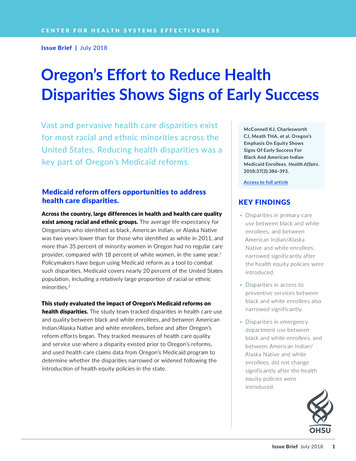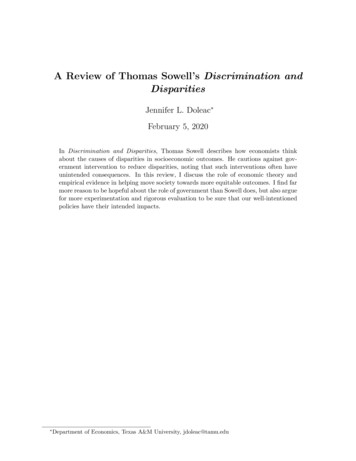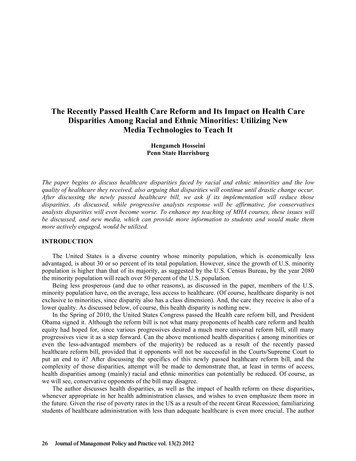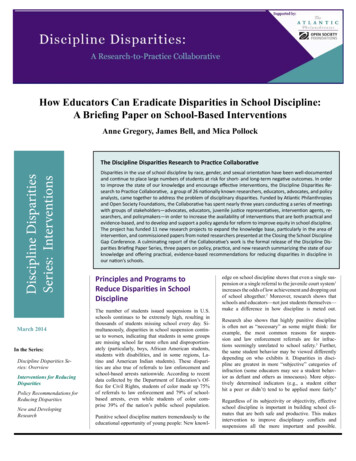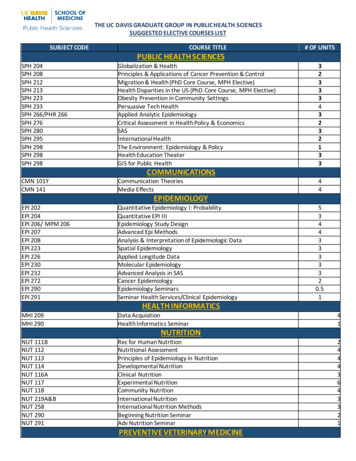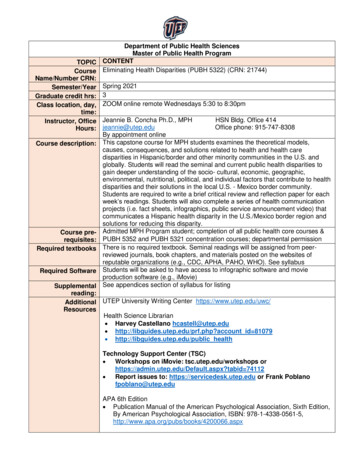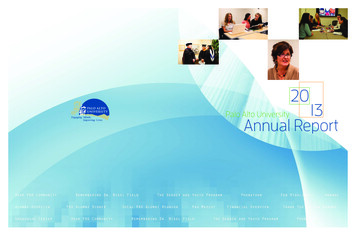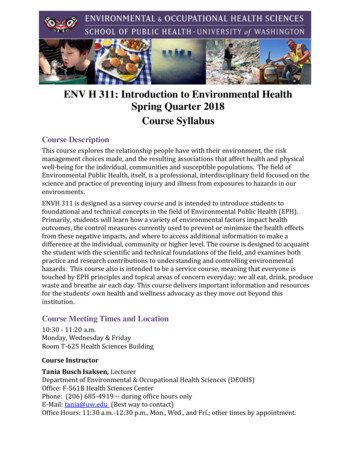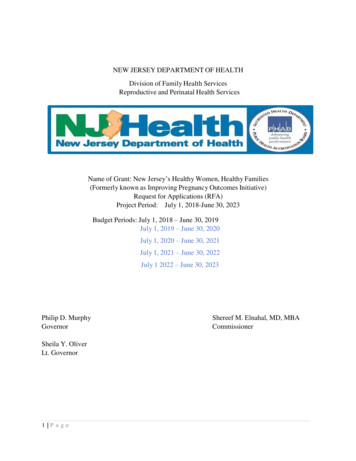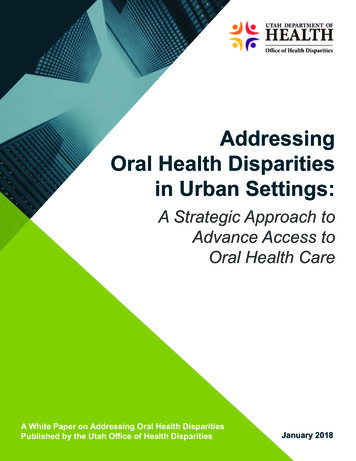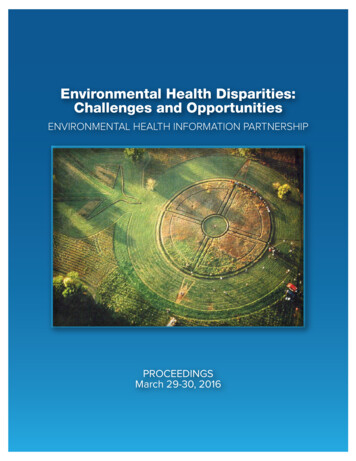
Transcription
Environmental Health Disparities:Challenges and OpportunitiesENVIRONMENTAL HEALTH INFORMATION PARTNERSHIPPROCEEDINGSMarch 29-30, 2016
Cover: Haskell Medicine Wheel EarthworkThe Haskell Medicine Wheel earthwork lies in the heart of the Haskell wetlands, located south of the HaskellIndian Nations University campus. It is a place for prayer, solitude, and reflection. Students, faculty, staff,and tribal elders designed the Haskell Medicine Wheel earthwork in association with crop artist and painterStan Herd. It was dedicated in 1992.The Medicine Wheel has been used by generations of various Native American tribes for health andhealing. It embodies the Four Directions, as well as Father Sky, Mother Earth, and Spirit Tree—all of whichsymbolize dimensions of health and the cycles of life.Cover photo by Jon Blumb
National Institutes of HealthNational Library of MedicineEnvironmental HealthInformation PartnershipProceedingsHaskell Indian Nations UniversityLawrence, KansasMarch 29–30, 2016Environmental Health Disparities:Challenges and OpportunitiesPrepared forDivision of Specialized Information ServicesNational Library of MedicinePrepared byHealth, Energy, and EnvironmentOak Ridge Associated Universities
This document was prepared for the Division of Specialized Information Services, National Library of Medicine,National Institutes of Health by the Oak Ridge Associated Universities (ORAU)ORAU provides innovative scientific and technical solutions to advance national priorities in science, education, security andhealth. Through specialized teams of experts, unique laboratory capabilities and access to a consortium of more than 100 majorPh.D.-granting institutions, ORAU works with federal, state, local and commercial customers to advance national priorities andserve the public interest. A 501(c)(3) nonprofit corporation and federal contractor, ORAU manages the Oak Ridge Institute forScience and Education (ORISE) for the U.S. Department of Energy (DOE). Learn more about ORAU at www.orau.org.
EnHIP Meeting: March 29–30, 2016CONTENTSHaskell Indian Nations University Profile . 1AGENDA. 3ATTENDEES. 6Day 1I.Meeting Opening and Welcome. 8II.Haskell Indian Nations Tribal Blessing . 8III.Remarks . 8IV.Remarks and NLM Update . 8V.Introductions . 9VI.Global and Regional Environmental Issues. 9VII.Discussion and Q&A with Dr. J. Michael Kuperberg. 10VIII.South Carolina Floods . 10IX.Discussion and Q&A with Dr. Milton A. Morris. 11X.Haskell Environmental Research Studies Discussion Panel. 11XI.Discussion and Q&A with Panel . 12XII.Presentation of Certificate to Dr. Ann Barbre . 12XIII.Indigenous Peoples, Lands, and Resources: Findings from the Third National ClimateAssessment . 13XIV.Discussion and Q&A with Dr. Timothy M. “Bull” Bennett . 14XV.Walking Tour of Haskell Indian Nations University Campus . 15XVI.Wrap-up and Day 2 Overview . 15Day 2XVII. Welcome and Introductions . 16XVIII. Environmental Epigenetics . 16iv
EnHIP Meeting: March 29–30, 2016XIX.Discussion and Q&A with Dr. Harriet Karimi Kinyamu. 17XX.Community Mapping. 17XXI.Discussion and Q&A with Mr. Kurt Menke . 18XXII. Results of EnHIP Institutional Assessment. 18XXIII. Discussion and Q&A with Ms. Janice E. Kelly. 19XXIV. Wrap-up of Day 2 . 19XXV. Closing Remarks. 19APPENDIX A: EnHIP Strategic Plan. 20APPENDIX B: Directory of Guest Speakers. 25APPENDIX C: Biographies. 26APPENDIX D: EnHIP Assessment Executive Summary. 31APPENDIX E: EnHIP Director of Current Representatives . 34APPENDIX F: EnHIP Executive Committee. 37APPENDIX G: Directory of Alternate Representatives . 38PICTORIAL HIGHLIGHTS. 41v
EnHIP Meeting: March 29–30, 2016Historyof HaskellIndianNations UniversityFor more than a century, theeducational needs of manyAmerican Indian and AlaskaNative youths have been metby a small school in Lawrence,Kansas. From the beginning,the institution’s curricula wereoriented toward American Indian and Alaska Native cultures.The school opened with 22 American Indian children in 1884. Enrollment at the United States IndianIndustrial Training School grew very quickly to more than 400 students.At first, the training school taught agricultural education and industrial trades. Boys learned farming, wagonmaking, harness making, blacksmithing,tailoring, shoe making, and painting.Girls learned cooking, sewing, andhomemaking.As a decade passed, the curriculumexpanded from elementary grades toalso include high school classes. Aschool to train high school graduatesto be teachers was added to address theneed for better education in the students’home communities. The CommercialDepartment, a predecessor of the BusinessDepartment, opened in 1895. It wasequipped with five typewriters; it isbelieved that the school’s type-touchingclass was the first one taught in Kansas.1
EnHIP Meeting: March 29–30, 2016The State of Kansas accredited the high school in 1927, leading to the addition of post-high school classesin several subject areas. Industrial training gained more importance in the early 1930s, and the schoolevolved into a vocational and technical training institution by 1935. With this new emphasis, the secondaryprogram was phased out, and the last high school class was graduated in 1965. During these decades, theschool’s athletic programs, particularly football, gained much recognition and led to the campus serving asthe home of the American Indian Athletic Hall of Fame.In 1970, the school began offering a junior college curriculum; this expanded curriculum brought about aname change—Haskell Indian Junior College. In 1992, the National Haskell Board of Regents recommendeda new name to reflect its vision for the institution as a national center for Indian education, research, andcultural preservation. The name Haskell Indian Nations University was approved in 1993.More than 1,000 students from federally recognized tribes from across the United States enroll everysemester. They select programs that will prepare them to enter baccalaureate programs in American Indianstudies, elementary education, business administration, and environmental science. They can choose totransfer to another baccalaureate degree-granting institute or enter directly into employment.Haskell University remains unique in many ways, perhaps foremost because of its intertribal constituencyand federal support through the Bureau of Indian Affairs. It continues to integrate American Indian andAlaska Native culture into all of its curricula.Photos: Haskell Indian Nations University2
EnHIP Meeting: March 29–30, 2016NATIONAL LIBRARY OF MEDICINEENVIRONMENTAL HEALTH INFORMATION PARTNERSHIP MEETINGTheme: Environmental Health Disparities: Challenges and OpportunitiesHaskell Indian Nations University, Lawrence, KansasNavarre Hall, Room 114March 29–30, 2016Patricia Matthews-Juarez, PhD, PresidingAGENDATUESDAY, MARCH 29, 20168:30 a.m. – 8:45 a.m.Registration8:45 a.m. – 9:15 a.m.Meeting Opening and WelcomePatricia Matthews-Juarez, PhDChairman, EnHIPHaskell Indian Nations Tribal BlessingRob BraveLakota Singer, Haskell Indian Nations UniversityRemarksVenida S. Chenault, PhDPresident, Haskell Indian Nations University9:15 a.m. – 9:25 a.m.Remarks and NLM UpdateBetsy L. Humphreys, MLSActing Director and Deputy Director, NLMIntroductions9:25 a.m. – 10:00 a.m.Global and Regional Environmental IssuesJ. Michael Kuperberg, PhDExecutive Director, U.S. Global Change Research Program10:00 a.m. – 10:15 a.m.Discussion and Q&AFacilitated by Ann Barbre, PhDXavier University of Louisiana10:15 a.m. – 10:30 a.m.South Carolina FloodsMilton A. Morris, PhDBenedict College3
EnHIP Meeting: March 29–30, 2016NATIONAL LIBRARY OF MEDICINEENVIRONMENTAL HEALTH INFORMATION PARTNERSHIP MEETINGHaskell Indian Nations UniversityNavarre Hall, Room 114AGENDA10:30 a.m. – 10:45 a.m.BREAK10:45 a.m. – 11:20 a.m.Haskell Environmental Research Studies Discussion Panel Daniel R. Wildcat, PhDHaskell Indian Nations University, Panel Moderator Bridgett Chapin, PhD, Haskell Indian Nations University Melinda M. Crow, MS, Haskell Indian Nations University11:20 a.m. – 12:00 p.m.Discussion and Q&AFacilitated by Daniel R. Wildcat, PhD12:00 p.m. – 1:30 p.m.LUNCHPresentation of Certificate to Ann Barbre, PhDBetsy L. Humphreys, MLSPatricia Matthews-Juarez, PhDIndigenous Peoples, Lands, and Resources: Findings from theThird National Climate AssessmentTimothy M. “Bull” Bennett, PhDPresident and CEO, Kiksapa Consulting, LLC.1:30 p.m. – 2:00 p.m.EnHIP Group PictureHaskell Indian Nations University Campus2:00 p.m. – 4:30 p.m.Walking Tour of Haskell Indian Nations University CampusLed by Haskell Eco AmbassadorsHaskell Cultural Center and MuseumTommaney HallSequoyah Hall4:30 p.m. – 4:45 p.m.Wrap-up and Day 2 OverviewPatricia Matthews-Juarez, PhD4
EnHIP Meeting: March 29–30, 2016NATIONAL LIBRARY OF MEDICINEENVIRONMENTAL HEALTH INFORMATION PARTNERSHIP MEETINGHaskell Indian Nations UniversityNavarre Hall, Room 114AGENDAWEDNESDAY, MARCH 30, 20168:30 a.m. – 8:45 a.m.Registration8:45 a.m. – 9:00 a.m.Welcome and IntroductionsPatricia Matthews-Juarez, PhDChairman, EnHIP9:00 a.m. – 9:45 a.m.Environmental EpigeneticsHarriet Karimi Kinyamu, PhDScientist, National Institute of Environmental Health Sciences9:45 a.m. – 10:00 a.m.Discussion and Q&AFacilitated by Robert Copeland, Jr., PhDHoward University College of Medicine10:00 a.m. – 10:15 a.m.BREAK10:15 a.m. – 10:45 a.m.Community MappingKurt Menke, MA, GISPFounder, Bird’s Eye View GISIntroduction and Discussion by John C. Scott, MSDirector, Center for Public Service Communications10:45 a.m. – 11:15 a.m.Results of EnHIP Institutional AssessmentJanice E. Kelly, MLSActing Deputy Associate Director, SIS, NLM11:15 a.m. – 11:30 a.m.Wrap-upGale Dutcher, MLS, MSActing Associate Director, SIS, NLM11:30 a.m. – 11:45 a.m.Closing RemarksPatricia Matthews-Juarez, PhD5
EnHIP Meeting: March 29–30, 2016U.S. DEPARTMENT OF HEALTH AND HUMAN SERVICESNATIONAL INSTITUTES OF HEALTHNATIONAL LIBRARY OF MEDICINE PROCEEDINGS OF THE ENVIRONMENTAL HEALTHINFORMATION PARTNERSHIP (EnHIP) MEETINGMarch 29‒30, 2016The Environmental Health Information Partnership (EnHIP) convened for its first session on March29, 2016, at 8:45 a.m. in Navarre Hall of Haskell Indian Nations University, Lawrence, Kansas. EnHIPChairman Dr. Patricia Matthews-Juarez, Professor and Vice President for Faculty Affairs and Development,Meharry Medical College, presided. The theme of the meeting was “Environmental Health Disparities:Challenges and Opportunities.” Representatives convened again March 30, 2016, at 8:45 a.m. at NavarreHall until adjournment at 11:45 a.m.ATTENDEESRepresentatives from Participating SchoolsDr. Ann Barbre, Xavier University of LouisianaMs. Dolores (Dee) E. Caffey-Fleming, Charles R. Drew University of Medicine and ScienceDr. Robert L. Copeland, Jr., Howard UniversityDr. Patricia Matthews-Juarez, Meharry Medical CollegeDr. Judith Mazique, Texas Southern UniversityDr. Arlene Montgomery, Hampton UniversityDr. Milton A. Morris, Benedict CollegeDr. T. Joan Robinson, Morgan State UniversityDr. Paul B. Tchounwou, Jackson State UniversityDr. Daniel R. Wildcat, Haskell Indian Nations UniversityDr. Doris Withers, Medgar Evers College, CUNYMs. Jessica Zephier, Oglala Lakota CollegeMs. Jill Ziemann, Colorado Mountain CollegeAlternate RepresentativesDr. Stephanie Bauer, University of Alaska AnchorageDr. Cheryl Davis, Tuskegee UniversityDr. João Ferreira-Pinto, The University of Texas at El PasoDr. Aramandla Ramesh, Meharry School of MedicineMr. Joe Swanson, Jr., Morehouse School of MedicineConsultant to the EnHIPMr. John C. Scott, Center for Public Services Communications6
EnHIP Meeting: March 29–30, 2016SpeakersDr. Bridgett Chapin, Haskell Indian Nations UniversityDr. Venida S. Chenault, President, Haskell Indian Nations UniversityMs. Melinda M. Crow, Haskell Indian Nations UniversityDr. Timothy M. “Bull” Bennett, President, Kiksapa Consulting, LLCDr. Harriet Karimi Kinyamu, Scientist, National Institute of Environmental Health Sciences, NIHDr. J. Michael Kuperberg, Executive Director, U.S. Global Change Research ProgramMr. Kurt Menke, Founder, Bird’s Eye View GISInvited GuestsMr. Ron Brave, Haskell Indian Nations UniversityMs. Lori Hasselman, Haskell Indian Nations UniversityEnvironmental Research Studies Students, Haskell Indian Nations UniversityNLM StaffMs. Betsy L. Humphreys, Acting Director, NLMMs. Gale Dutcher, Acting Associate Director, Division of Specialized Information Services, NLMMs. Cynthia Gaines, Project Officer, Division of Specialized Information Services, NLMMs. Janice E. Kelly, Acting Deputy Associate Director, Division of Specialized Information Services, NLMORAU StaffMs. Wilma Templin-Branner, Oak Ridge Associated UniversitiesMs. Linda Lange, Oak Ridge Associated Universities7
EnHIP Meeting: March 29–30, 2016Day 1I. Meeting Opening and WelcomeEnHIP Chairman Dr. Patricia Matthews-Juarez, Professor and Vice President for Faculty Affairs andDevelopment, Meharry Medical College, opened the meeting on March 29, 2016, at 8:45 in Room 114,Navarre Hall, Haskell Indian Nations University, Lawrence, Kansas. The theme of the meeting was“Environmental Health Disparities: Challenges and Opportunities.”II. Haskell Indian Nations Tribal BlessingDr. Daniel R. Wildcat, EnHIP representative of Haskell Indian Nations University, spoke in his nativelanguage and English to welcome everyone to the campus where he has been for 30 years. He is a Yuchimember of the Muscogee Nation of Oklahoma. Dr. Wildcat introduced Mr. Ron Brave, Lakota Singer,Haskell Indian Nations University. Mr. Brave offered a song and delivered a tribal blessing in the Lakotalanguage. Dr. Wildcat introduced Dr. Venida S. Chenault, President, Haskell Indian Nations University.III. RemarksDr. Venida S. Chenault, President, Haskell Indian Nations University, explained that speaking and singingin native languages are expressions of world view, culture, and philosophies. She introduced herself in hernative language, saying she is of the Bear Clan. She belongs to the Prairie Band Potawatomi Nation andKickapoo Tribe.“I thank our Father Creator for bringing us together today,” said Dr. Chenault as she extended a graciouswelcome to the group. She described the Earth as the Mother that nurtures the people and provides for theirneeds. If people destroy the Earth through unwise practices, they destroy their future.Environmental issues and their consequences are often disproportionately borne by people without resourcesand access. Oftentimes, these are people of color. Disruptions to the environment and a way of life over anextended time sometimes cause people within tribal communities to act with violence, yet this reaction iscontradictory to the nature of indigenous people. To solve environmental issues, people will be required toengage collaboratively and use collective knowledge.Dr. Chenault is the seventh president of Haskell Indian Nations University. Throughout her professionalcareer, Dr. Chenault has advocated for supporting the role of higher education in solving social, legal,political, environmental, and cultural issues in Indian Country. Her research focuses on violence and abuseagainst indigenous women.IV. Remarks and NLM UpdateMs. Betsy L. Humphreys, Acting Director and Deputy Director, NLM, provided an update on the transitionoccurring at NLM following the retirement of Dr. Donald A.B. Lindberg in 2015. She expects theannouncement of a new director in April or May. She noted that the Library’s current Long-Range StrategicPlan extends through 2016. The new director will seek input from various advisory groups during thedevelopment of the next strategic plan. Ms. Humphreys encouraged representatives to think about EnHIP’sgoals and objectives for future initiatives and consider possible different directions for the Partnership. Sheis looking forward to her continued association with representatives as a new director takes the helm ofNLM.8
EnHIP Meeting: March 29–30, 2016Ms. Humphreys reflected on the environmental problems of 1991, the Partnership’s first year, and presentday challenges associated with climate change. She referenced the recent reemergence of the Zika andchikungunya viruses and predicted populations will deal with infectious diseases more frequently in thefuture as climate change impacts environments.V. IntroductionsDr. Matthews-Juarez thanked Dr. Chenault for the opportunity to convene at Haskell Indian NationsUniversity and Ms. Humphreys for the NLM update. Dr. Matthews-Juarez welcomed representatives,speakers, and invited guests and asked them to introduce themselves.VI. Global and Regional Environmental IssuesDr. J. Michael Kuperberg, Executive Director, U.S. Global Change Research Program, spoke of majorfindings related to human health from the most recent National Climate Assessment (2014) and more recentclimate and health assessments. Dr. Kuperberg is on detail to the White House from the U.S. Department ofEnergy’s Office of Science where he managed environmental research programs for the past decade.Dr. Kuperberg’s current assignment is in the Office of Science and Technology Policy, led by Dr. John P.Holdren, Assistant to the President for Science and Technology and co-chair of the President’s Council ofAdvisors on Science and Technology. President Barack Obama has a strong interest in science and usesscience to inform his decisions, according to Dr. Kuperberg.The National Science and Technology Council oversees the work of various activities across the federalgovernment, including the Committee on Environmental Natural Resources and Sustainability. TheSubcommittee on Global Change Research began in 1989 and was mandated by the U.S. Congress in1990 to assist the nation and the world to understand, assess, predict, and respond to human-induced andnatural processes of global change. The Global Change Research Program involves 13 federal agencies,each providing information in their areas of expertise. In 2016, 2.5 billion in funding were allocated forresearch.The release of the U.S. Global Change Research Program’s Climate and Health Assessment is scheduledfor this spring. A team of 100 experts from eight federal agencies and departments contributed to the reporttitled “The Impacts of Climate Change on Human Health in the United States: A Scientific Assessment.” Itsynthesizes literature searches, assesses peer-reviewed science, weighs evidence, and provides confidencelevels for key findings. Four chapters highlight recently published federal quantitative analyses of projectedhealth impacts.The National Climate and Health Assessment emphasized wide-ranging impacts related to climate change:extreme weather events, decreased air quality, threats to mental health, and illness transmitted by food,water, and disease carriers such as mosquitos and ticks. Increased rates of diabetes and respiratory diseasessuch as asthma are tied directly to increased vulnerability and sensitivity to environmental factors. Extremeprecipitation events impact crops and water quality. The number of days and number of regions withextreme temperatures are increasing and causing dramatic changes to the way of life for many populations.“Climate change will—absent other changes—amplify some of the existing health threats the nation nowfaces. Certain people and communities are especially vulnerable, including children, the elderly, the sick,the poor, and some communities of color,” said Dr. Kuperberg. Public health actions, preparedness, andprevention can protect people; however as threats increase, the ability to adapt to future changes may belimited.9
EnHIP Meeting: March 29–30, 2016Dr. Kuperberg asked representatives to conduct research and contribute to assessments for the fourthNational Climate Assessment, slated for delivery in 2018. The Global Change Research Program considersmany areas of environmental research for inclusion in the National Climate Assessment, so he urgedrepresentatives to stay in contact about their published research. He encouraged them to respond positivelywhen asked to review scientific documents.VII. Discussion and Q&A with Dr. J. Michael KuperbergMr. John Scott, Center for Public Service Communications, asked about cultural changes related toadaptations, particularly as populations are forced to move because of shifts in their environment. Dr.Kuperberg said it is challenging for chemists, biologists, and atmospheric scientists to answer questionsabout the science of adaptation. The U.S. Global Change Research Program has received requests from theNational Academy of Sciences to expand its research program into the social sciences.Dr. Milton A. Morris, Benedict College, asked to what extent climate change is being taught at universities.Dr. Kuperberg was aware of some universities where climate change is an active area of education, but heviewed those as isolated pockets. Representatives expressed interest in internship opportunities for theirstudents.In his closing statements, Dr. Kuperberg said, “The challenges we face are not so much about the world.We have built infrastructure, and we’ve built a society that’s not resilient, that has not adapted to a dynamicworld. Yet, we have increased the dynamism of the world, and we’re going to suffer if we can’t figure out away to deal with this. So, we’re really not so much worried about saving the world. The world will live on.It’s about trying to save us.”VIII. South Carolina FloodsDr. Milton A. Morris, Director, Environmental Health Science Program, Benedict College, gave anoverview of the destruction brought on by heavy rains that swept across eastern and central South Carolina,his home state. In October 2015, record-breaking rainfall caused flooding, with Mount Pleasant receiving26.88 inches of rain over a four-day period. Columbia and Charleston received 8.19 and 6.40 inches of rain,respectively, over a 12-hour period.The heavy rainfall merited the moniker “1,000-year event” because statistically the precipitation amounthas a 0.1% chance of occurring in a given year. The movement of very moist air over a stalled frontalboundary near the coast generated the extraordinary rainfall. The clockwise circulation around a stalledupper level low over southern Georgia directed a narrow plume of tropical moisture northward and thenwestward across South Carolina over four days. The outer circulation of Hurricane Joaquin, situated off thecoast, added more tropical moisture to the weather system.In a slide presentation, Dr. Morris showed stranded citizens, flooded homes, sagging power lines, collapsedroads, abandoned vehicles, damaged cemeteries, and closed businesses. The rainfall and flooding adverselyaffected all socioeconomic levels of communities; agricultural regions and wildlife areas felt impacts, suchas soil erosion and displaced animals.South Carolina National Guard and South Carolina Environmental Management Agency providedimmediate assistance to residents. In subsequent months, an analysis by the Carolinas Integrated Sciencesand Assessments at the University of South Carolina illuminated lessons to be learned about communityresilience in the wake of extreme weather events. As the region gains population and expands development,10
EnHIP Meeting: March 29–30, 2016the potential grows for greater economic and environmental impacts, thus underscoring the need for greaterresilience during recovery.IX. Discussion and Q&A with Dr. Milton A. MorrisDr. Paul B. Tchounwou, Jackson State University, asked about the impact on the state’s economy. Dr.Morris indicated agricultural areas across the state suffered severe economic losses, and coastal areas suchas Charleston and Myrtle Beach experienced a severe drop in tourism earnings. Responding to Dr. Wildcat’squestion about regulation of future coastal development, Dr. Morris indicated there is constant argumentwithin the state legislature and at local levels about protecting the environment and developing coastal ar eas. “Both sides have strong arguments. It happens politically all the time,” said Dr. Morris.X. Haskell Environmental Research Studies Discussion PanelDr. Daniel R. Wildcat, Acting Dean, College of Natural and Social Sciences, Haskell Indian NationsUniversity, and Director, Haskell Environmental Research Studies (HERS) Center, described recent en vironmental research projects. The Center opened in 1995 in partnership with the University of Kansasto advise communities and provide research opportunities and training for students. The Center promotessustainable and restorative activities for native communities and environmental health. It has worked inpartnerships with National Aeronautics and Space Administration, National Oceanic and AtmosphericAdministration, National Center for Atmospheric Research, U.S. Environmental Protection Agency, andother federal agencies.With assistance from a National Science Foundation grant, the Native People’s Native Homelands programhas allowed staff and students to study wetlands on the southern edge of campus. A seven-week geographicinformation system (GIS) geoscience “boot camp” teaches students about designing projects. Past projectsincluded studies on air and water quality and declines in biodiversity. Two new projects through the U.S.Environmental Protection Agency examine actions to reduce food waste and the carbon footprint and wateruse on campus.Dr. Wildcat, who served as panel moderator, introduced two colleagues, Dr. Bridgett Chapin and Ms.Melinda M. Crow.Dr. Bridgett Chapin, Professor, Environmental Science, Haskell Indian Nations University, has a strong in terest in indicators of environmental change, and she is an active proponent of community-based research.Also, she integrates environmental topics into other programs so students enrolled in business, elementaryeducation, and indigenous and American Indian studies are connected to the environmental science re search and curriculum.One of the research projects developed at the University with funding from the Kansas Network ofBiomedical Research Excellence involved students identifying a topic of interest, preparing a proposal,working with a mentor, and executing research. One student’s project in Arizona’s White Mountains in volved testing water for phosphorus levels; the research motivated the student to continue his education ina graduate program.Dr. Chapin developed a “Building a Network for Environmental Problem Solving” class as a means to con nect students to r
Timothy M. "Bull" Bennett, PhD President and CEO, Kiksapa Consulting, LLC. 1:30. p.m. - 2:00 p.m. EnHIP Group Picture Haskell Indian Nations University Campus . 2:00 p.m. - 4:30 p.m. Walking Tour of Haskell Indian Nations University Campus . Led by Haskell Eco Ambassadors . Haskell Cultural Center and Museum Tommaney Hall . Sequoyah .
